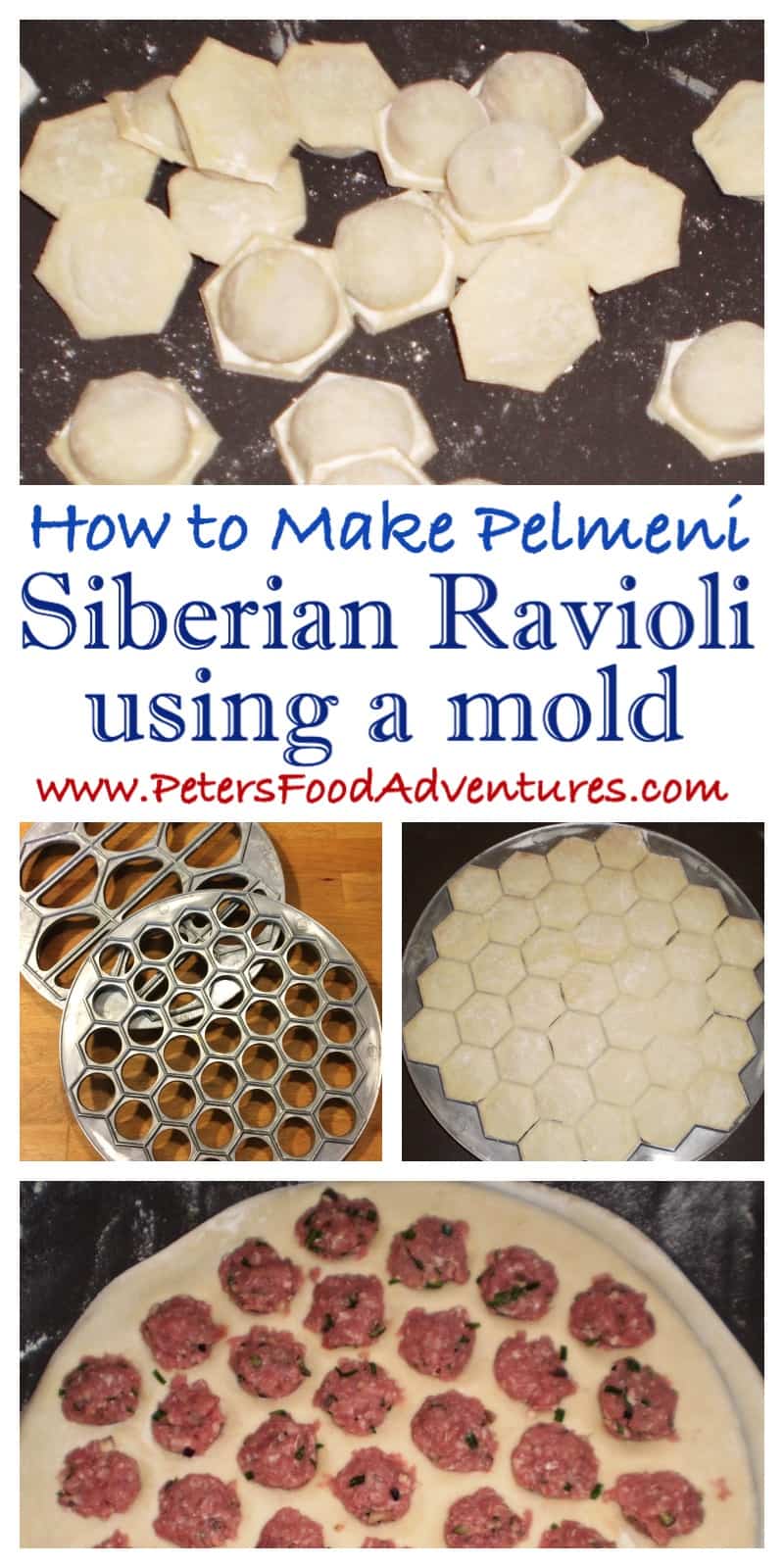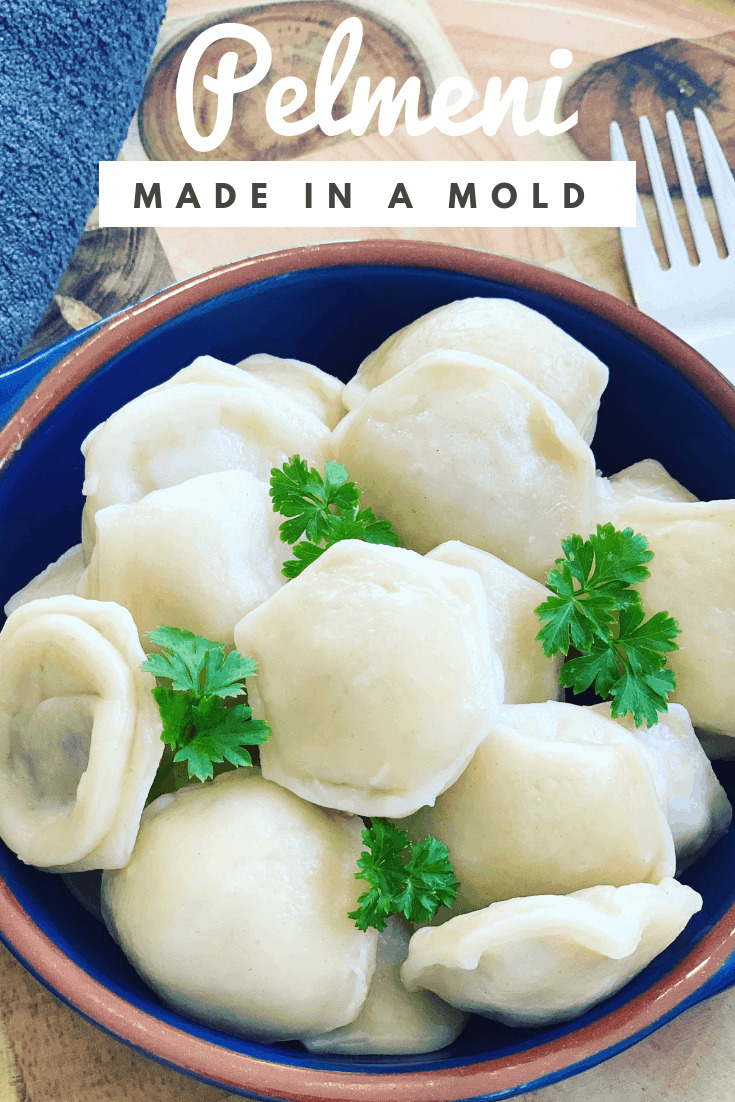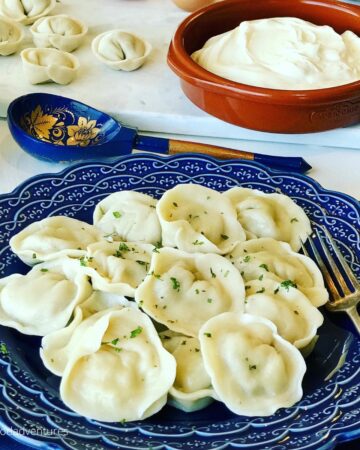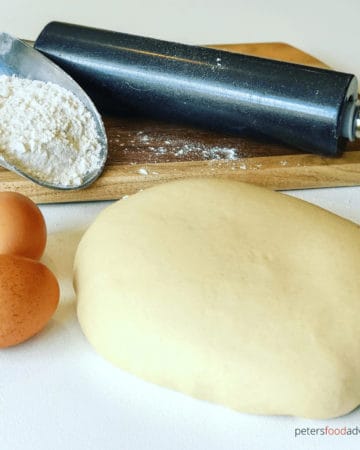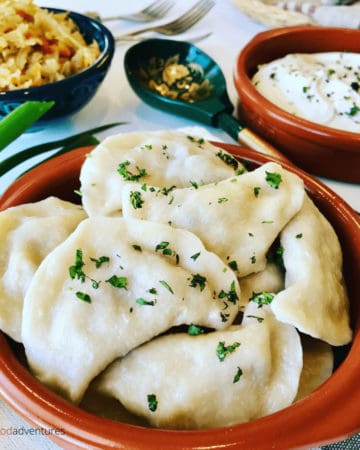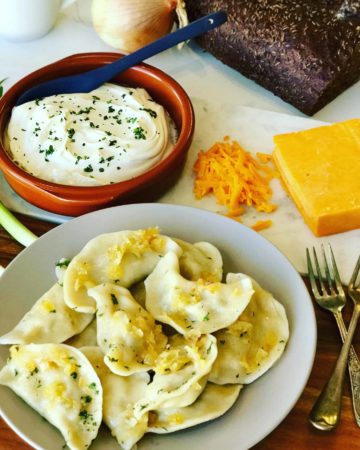Making Chicken Pelmeni using a mold is considered the easy way to make tasty homemade dumplings. The secret to this recipe is the juicy meat filling, made with ground chicken.
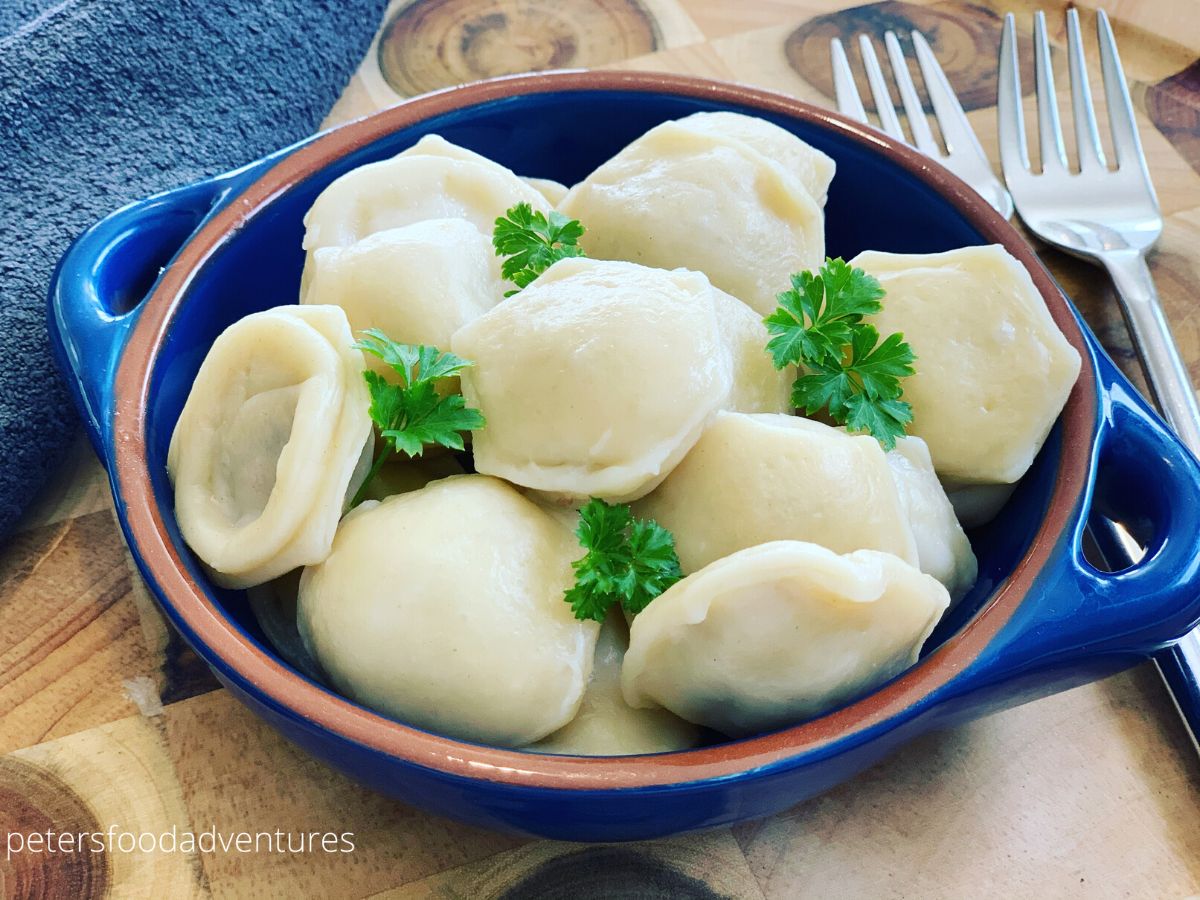
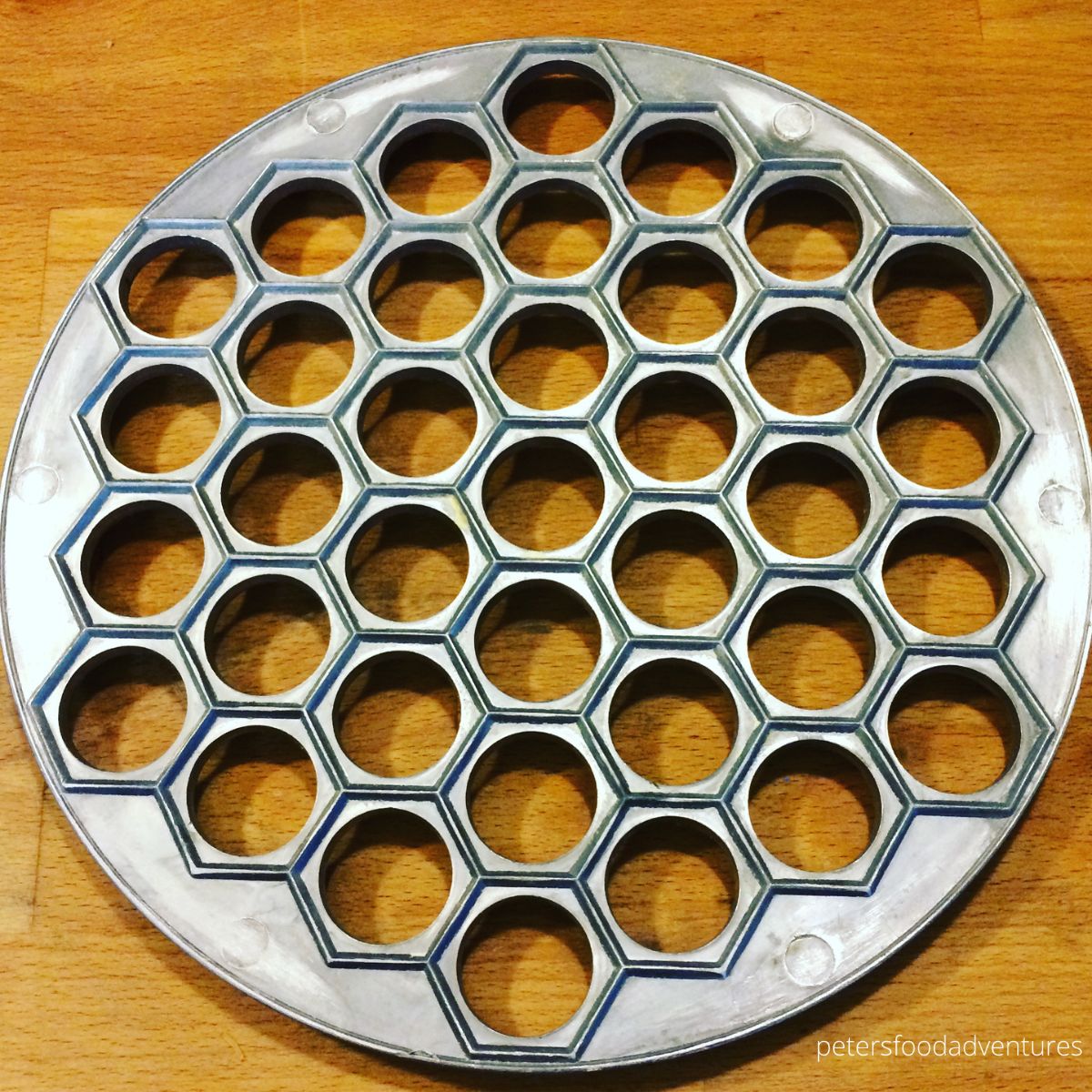
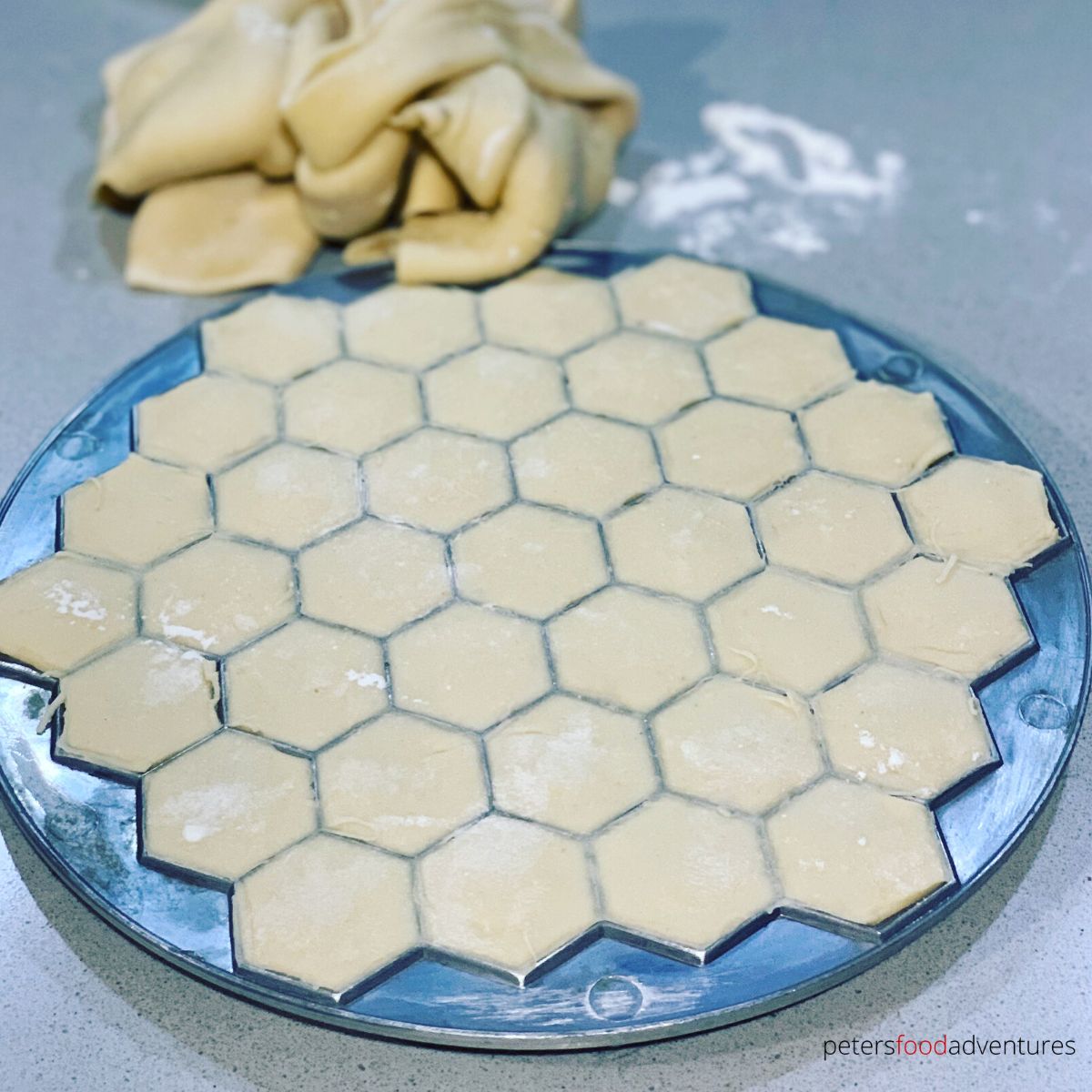
Anglo cultures have their typical meat, potato and vegetable meals. Italians have their pasta meals, but this I suppose is the Russian version of a pasta comfort meal. As long as I can remember, making Pelmeni (Пельмени) was something we did together as a family.
Pelmeni Mold
This recipe shows you how to make Pelmeni using a Mold called a Pelmennitsa (пельменница). You can buy them on Amazon or Ebay. They are like round metal pelmeni makers similar to a Ravioli mold. All you need is 2 rolled out sheets of dough, the filling and a rolling pin. The benefit of using a mold is that it make 37 Pelmeni at once, so you can make it by yourself. See how I make traditional Pelmeni.
Juicy Pelmeni Filling
Pelmeni filling should be juicy and tender. To make it really tender and juicy, you need more than onions and meat. My secret Pelmeni filling ingredient is Napa Cabbage. The tenderest of cabbages, neutral in flavor, adds a tender texture and juiciness to your Pelmeni. You don't need a lot, only 2 cups of finely shredded cabbage. Don't use regular green cabbage, as it's tougher and has a flavor that overpowers the meat.
Chicken Pelmeni
This is a Chicken Pelmeni recipe. Although traditionally made with beef or pork, using chicken is healthier and has less calories. Sometimes we make it with ground turkey. You can use any type of ground meat for Pelmeni.
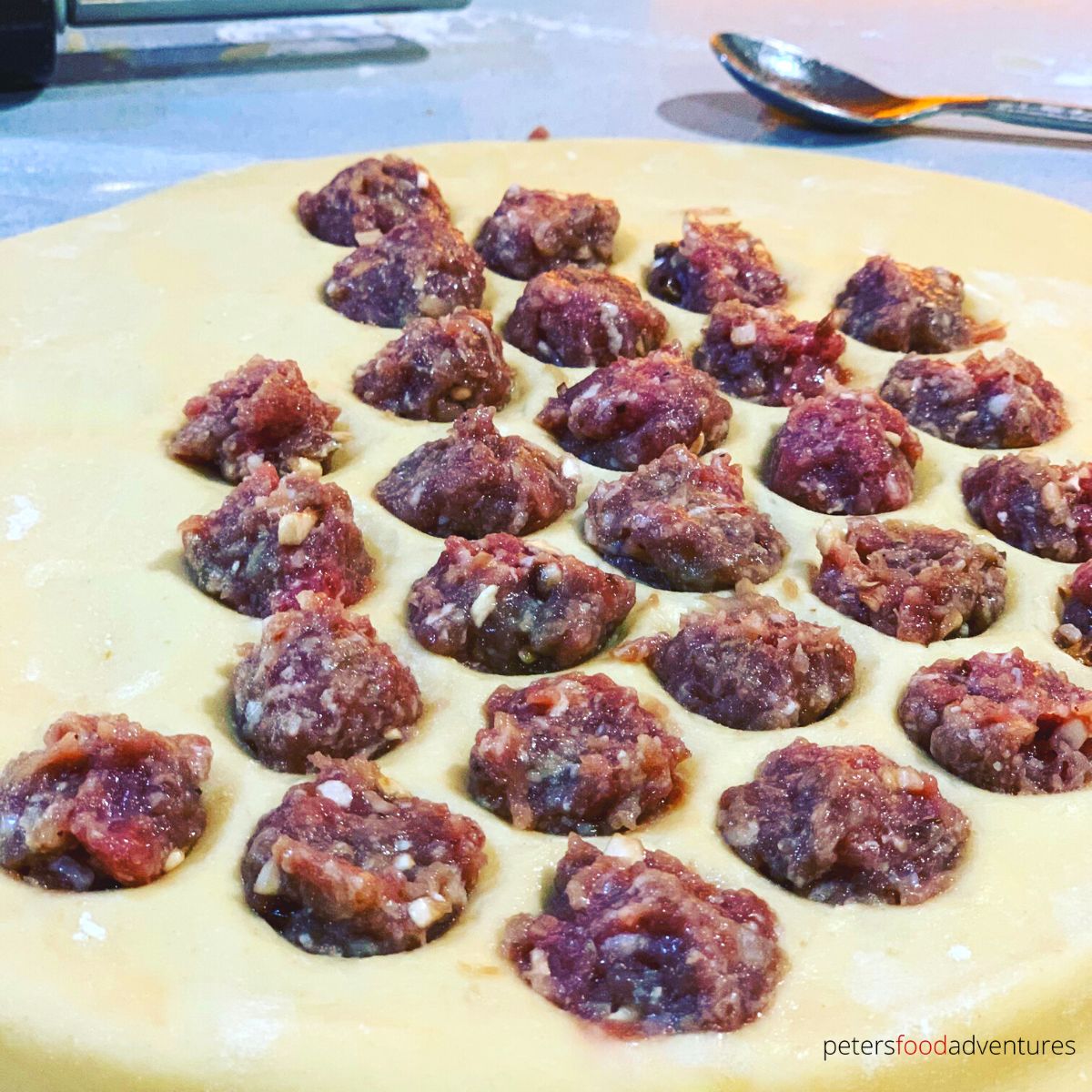
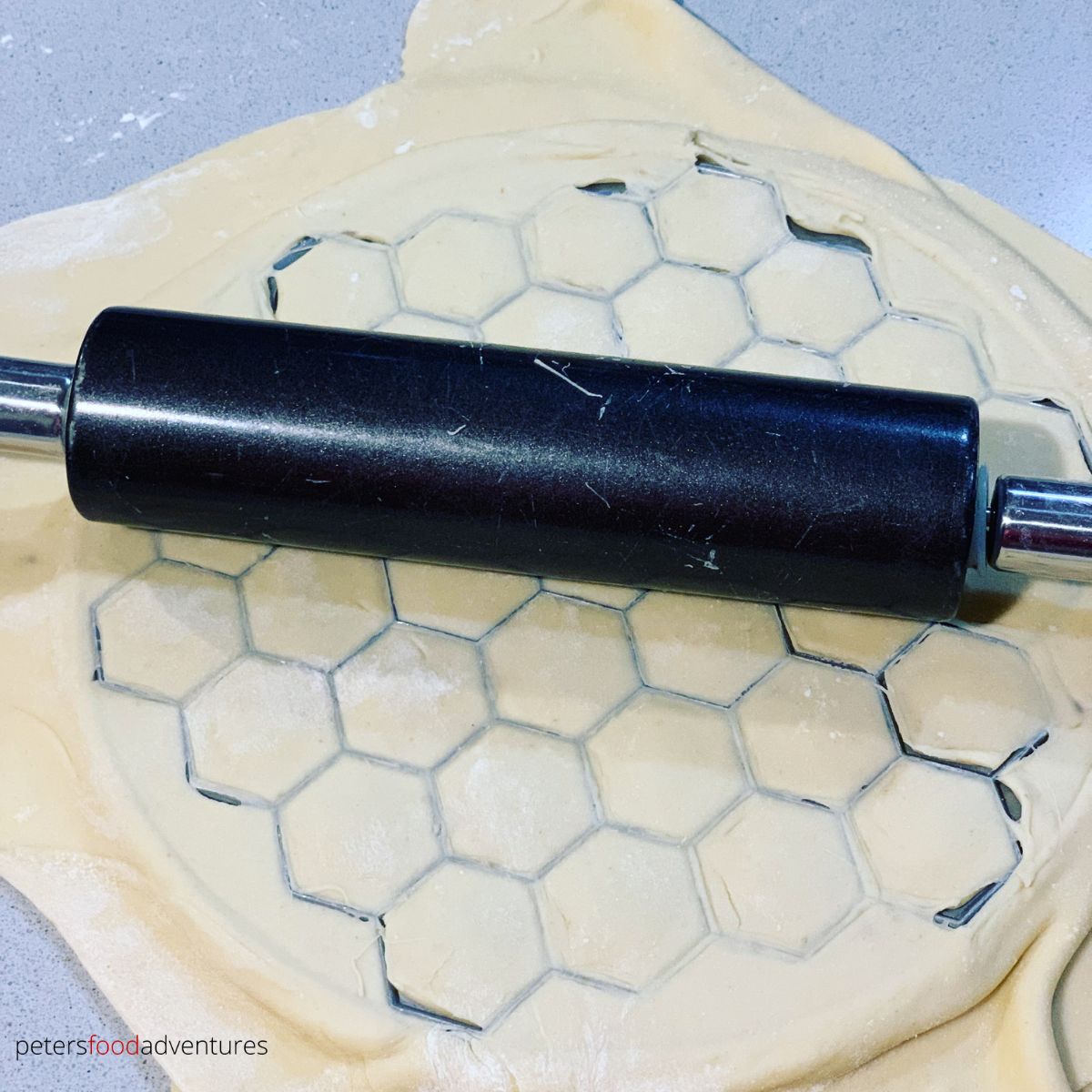
Ingredients
Chicken Pelmeni Filling
- 2 lbs (1kg) ground chicken
- 1 medium onion, grated
- 2 cups Napa Cabbage, finely shredded
- 1 clove minced garlic
- 1 tablespoon oil
- ½ teaspoon salt
- ½ teaspoon pepper
Pelmeni Dough
- 4 cups plain flour (plus a bit extra for kneading)
- 2 eggs
- 1 cup lukewarm water
- 1 teaspoon salt
Making Pelmeni Dough
Traditionally you make Pelmeni dough by hand. It doesn't take long and has been been made that way for hundreds of year. However, I've included instructions for a dough hook method, which I use my KitchenAid mixer.
Traditional Method
- Place flour into a bowl and make a well in the centre.
- Crack the eggs into the flour. Using a fork, stir the eggs into the flour.
- Slowly add salty water while kneading, until the dough forms a sticky ball.
- Continue to knead the dough on a floured surface until dough is soft but not sticky. Knead the dough for about 5 minutes.
- Cover the dough with a bowl and allow to rest for about an hour.
Dough Hook Method
- Place the dough hook on your stand mixer (I use KitchenAid).
- Add eggs, water, salt, oil, and quickly whisk together.
- Add 2 cups flour into the mixer, allowing dough hook to combine ingredients on Speed 2. Slowly add 2 more cups of flour until dough doesn't stick to the sides of the bowl.
- Knead on Speed 2 for a few minutes until dough is soft an elastic. Add extra flour if necessary if dough is sticky (a tablespoon at at time).
- Cover with cling wrap and allow to rest for about an hour.
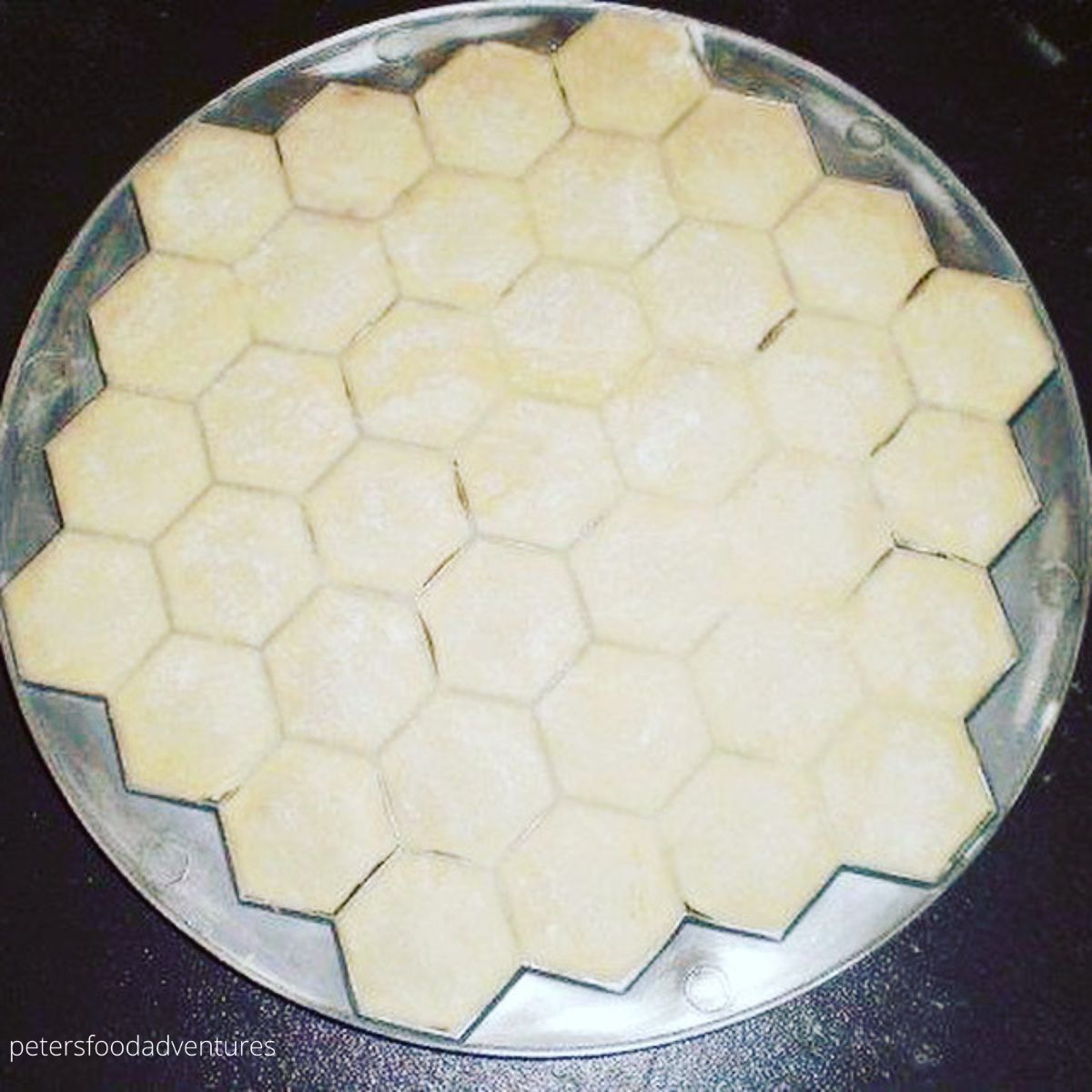
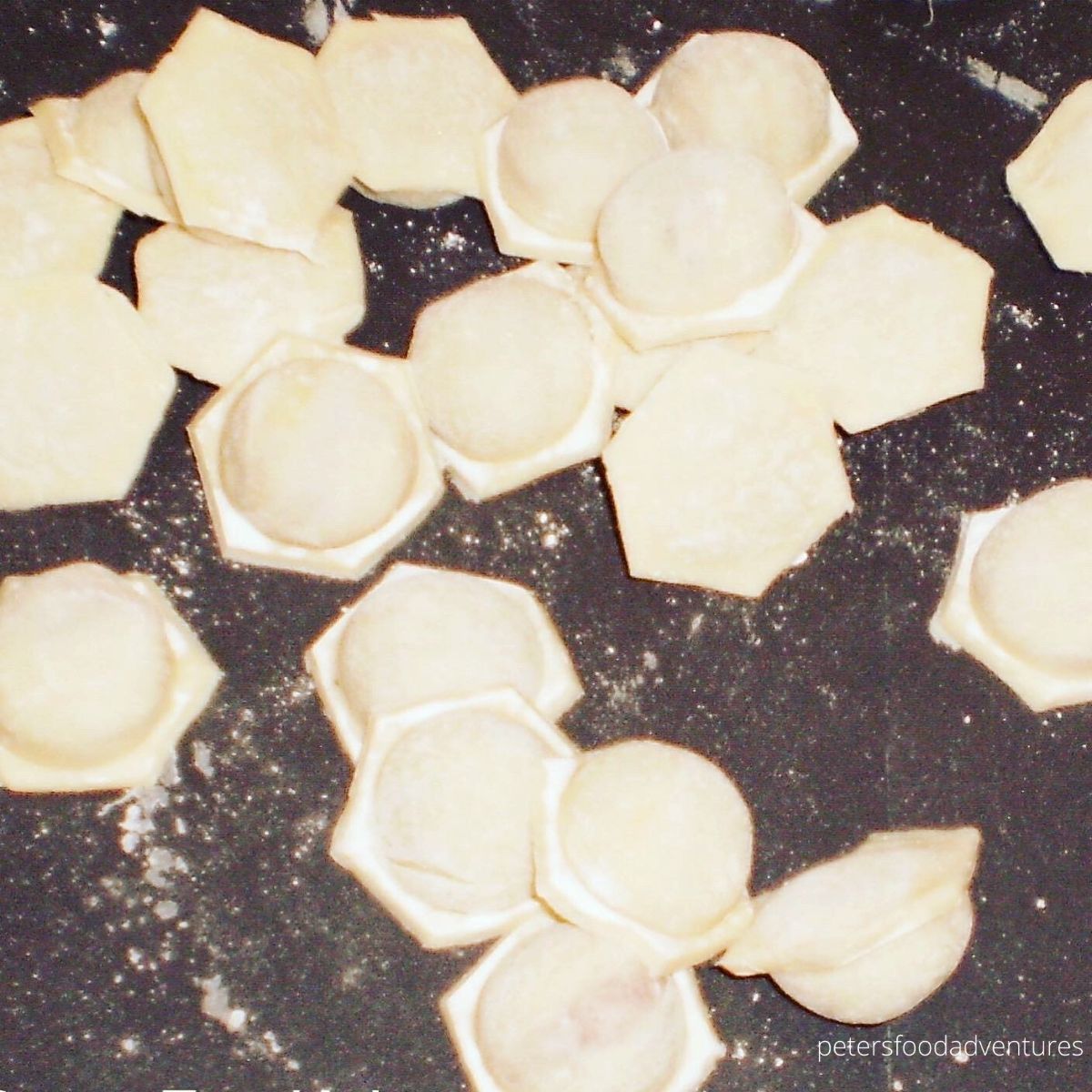
How to make Pelmeni Using a Mold
This Pelmeni Mold or Pelmeni Maker was bought on Amazon. I'm always trying to find a faster way to make them. I'm honestly not sure it's faster, especially if you're making them alone. Making Pelmeni using a Mold (Pelmennitsa) ensures the Pelmeni are all even and uniform in size.
- Cut off a piece of dough the size of your fist. Roll out with a rolling pin about ⅛" thin. It should be larger than the Pelmeni mold. Keep the remaining dough under the upside down bowl.
- Flour the Pelmeni mold and carefully drape the dough over.
- Using ½ a teaspoon of chicken mixture, place over each pocket of the mold. Take care not to be messy with your meat mixture, and keep the meat in the designated hole. Otherwise the dough layer will not bind together, and come unstuck in the cooking process.
- Roll out another round piece of dough and place the mold.
- Lightly flour the top of the rolled dough. Starting in the centre, use a heavy rolling-pin to roll the pelmeni until they bind together, and each piece is defined and separate.
- Flip the mould over, using your finger carefully poke out the individual Pelmeni or shake it to get them out of the mold.
- Place the pelmeni on an uncovered tray that's sprinkled with flour and freeze for at least 30 minutes. Place the individually frozen pelmeni into a Ziplock bag for an easy dinner later.
Freezing Pelmeni
Mom always had large aluminum baking trays that we would fill up with pelmeni, and they would go into the freezer. Once frozen solid, she'd put them into Ziploc bags for a quick meal that could feed the family at a moments notice. Remember to sprinkle the trays with flour before placing the Pelmeni to prevent sticking. Frozen Pelmeni make a quick and delicious meal, made with love.
Cooking Pelmeni
Pelmeni are cooked in boiling salted water, similar to pasta. Place the frozen Pelmeni into boiling water and cook them for about 6-8 minutes. They will float to the top around 5 minutes, and after they do, boil for another 3 minutes until meat is cooked. Drain, toss with butter and serve garnished with parsley or dill. Most commonly served with Smetana (sour cream) or Ketchup.
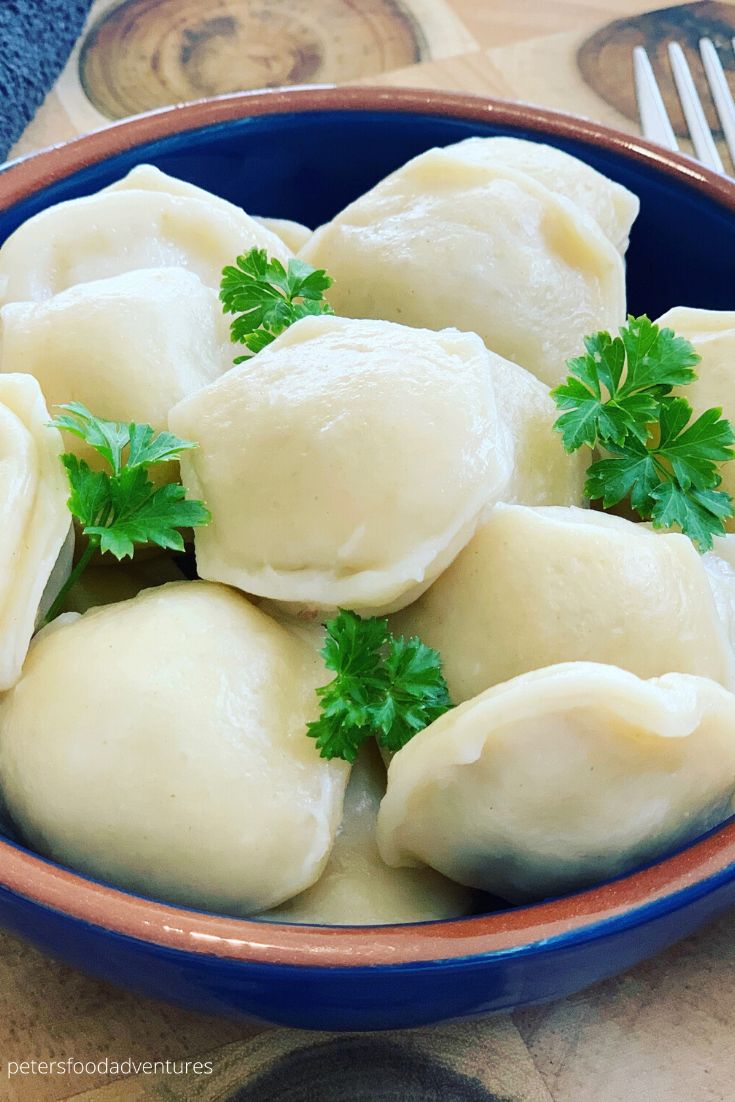
Other Slavic Dumplings
There are many types of dumplings in Eastern Europe, with much cross pollination in our kitchens and cultures. You'll love these dumpling recipes too!
- Traditional Pelmeni - handmade with tips and variations
- Vareniki with Tvorog - a traditional cheese dumpling
- Potato and Cheese Pierogies - the Americanized version of Pierogi
- Manti - a central Asian classic, this version has pumpkin
- Khinkali - my favorite Georgian dumpling
- Galushki Soup - dough dumplings in a meaty soup
So now you know how to make Chicken Pelmeni using a Mold. The kids will love eating them, and such a time saver when you need a quick and lazy dinner! Bon Appetit! Приятного аппетита!
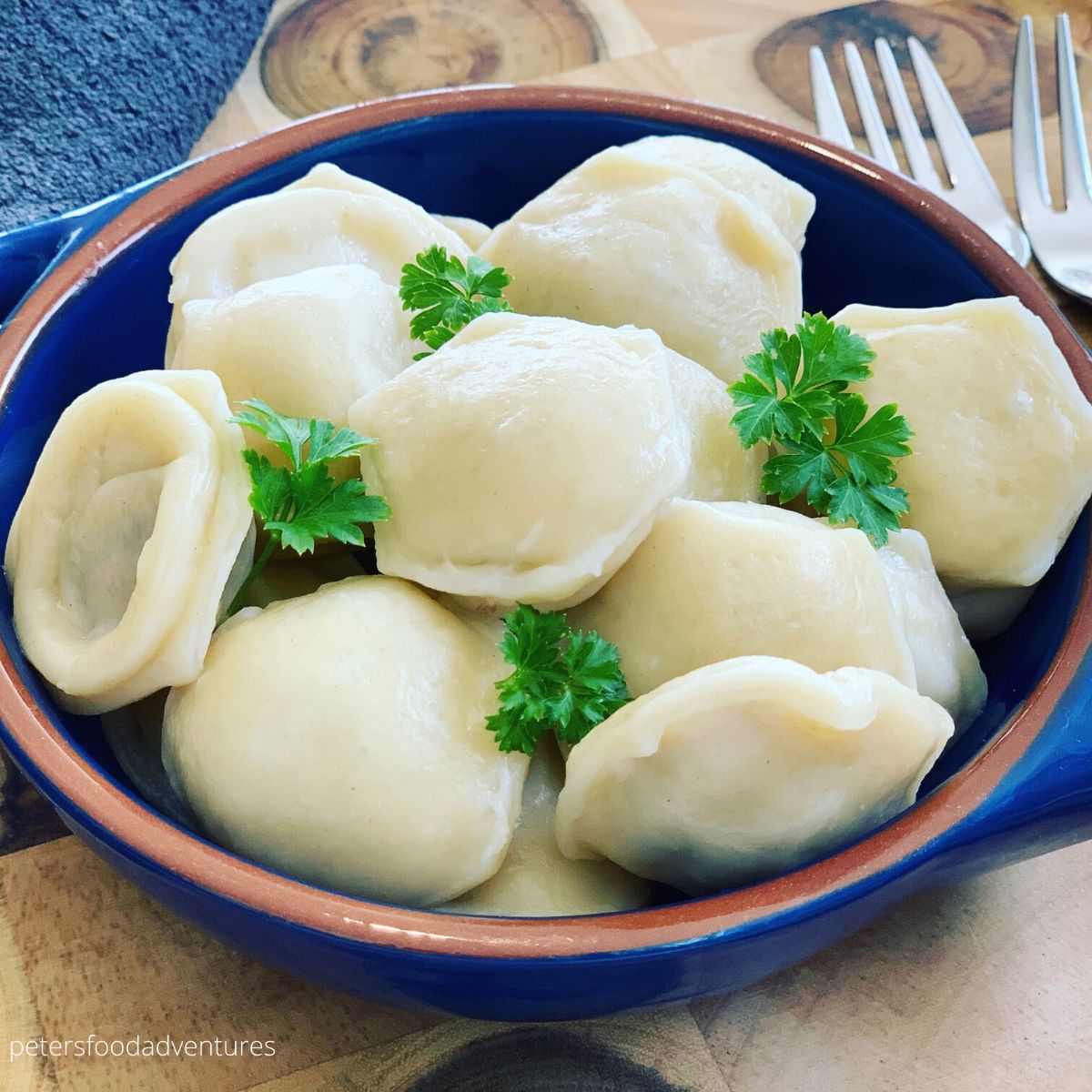
Equipment
- Pelmeni Mold (pelmennitsa)
Ingredients
Pelmeni Filling
- 2 lbs (1kg) of lean ground chicken
- 1 medium onion grated
- 2 cups Napa Cabbage finely shredded
- 1 clove garlic minced
- 1 tablespoon oil
- ½ teaspoon salt
- ½ teaspoon pepper
Pelmeni Dough
- 4 cups plain flour plus more for dusting
- 2 eggs
- 1 cup lukewarm salty water 1 tsp of salt
- Pelmeni mold пельменница
Instructions
Pelmeni Dough
- Place flour into a bowl and make a well in the centre. Crack the eggs into the flour.
- Using a fork, stir the eggs into the flour. Slowly add salty water while kneading, until the dough forms a sticky ball.
- Continue to knead the dough on a floured surface until dough is soft but not sticky. Knead the dough for about 5 minutes.
- Cover the dough with a bowl and allow to rest for about an hour.
Pelmeni Filling
- Using your hands, mix the ground chicken, onion, Napa Cabbage, garlic, oil, salt and pepper until combined.
Making Pelmeni with Mold
- Cut off a piece of dough the size of your fist. Roll out with a rolling pin about ⅛" thin. It should be larger than the Pelmeni mold. Keep the remaining dough under the upside down bowl.
- Flour the Pelmeni mold and carefully drape the dough over.
- Using ½ a teaspoon of chicken mixture, place over each pocket of the mold. Take care not to be messy with your meat mixture, and keep the meat in the designated hole. Otherwise the dough layer will not bind together, and come unstuck in the cooking process.
- Roll out another round piece of dough and place the mold.
- Lightly flour the top of the rolled dough. Starting in the centre, use a heavy rolling-pin to roll the pelmeni until they bind together, and each piece is defined and separate.
- Flip the mould over, using your finger carefully poke out the individual Pelmeni or shake it to get them out of the mold.
- Place the pelmeni on an uncovered tray that's sprinkled with flour and freeze for at least 30 minutes. Place the individually frozen pelmeni into a Ziplock bag for an easy dinner later.
Cooking Pelmeni
- Bring a large pot of salted water to a boil.
- Drop 25-30 pelmeni into the boiling water. Gently stir, to prevent the Pelmeni from sticking together.
- Simmer until the meat and dough is cooked approx 6-8 minutes
- Remove with a slotted spoon and serve with sour cream and dill.
©PetersFoodAdventures.com
